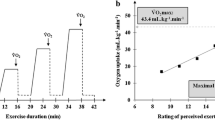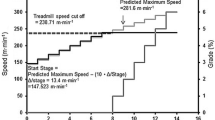Abstract
The validity of predicting peak oxygen uptake (\( \dot{V}{\text{O}}_{{ 2 {\text{peak}}}} \)) in sedentary participants from a perceptually regulated exercise test (PRET) is limited to two cycle ergometry studies. We assessed the validity of a treadmill-based PRET. Active (n = 49; 40.7 ± 13.8 years) and sedentary (n = 26; 33.4 ± 13.2 y) participants completed two PRETS (PRET 1 and PRET2), requiring a change in speed or incline corresponding to ratings of perceived exertion (RPE) 9, 11, 13 and 15. Extrapolation of RPE: \( \dot{V}{\text{O}}_{2} \) data to RPE 19 and 20 from the RPE 9–13 and 9–15 ranges were used to estimate \( \dot{V}{\text{O}}_{{ 2 {\text{peak}}}} \), and compared to \( \dot{V}{\text{O}}_{{ 2 {\text{peak}}}} \) from a graded exercise test (GXT). The \( \dot{V}{\text{O}}_{2} \) :heart rate (HR) data (≥RPE 15) from the GXT were also extrapolated to age-predicted maximal HR (HRmaxpred) to provide further estimation of \( \dot{V}{\text{O}}_{{ 2 {\text{peak}}}} \). ANOVA revealed no significant differences between \( \dot{V}{\text{O}}_{{ 2 {\text{peak}}}} \) predictions from the RPE 9–15 range for PRET 1 and PRET 2 when extrapolated to RPE 19 in both active (54.3 ± 7.4; 52.9 ± 8.1 ml kg−1 min−1) and sedentary participants (34.1 ± 10.2; 34.2 ± 9.6 ml kg−1 min−1) and no difference between the HRmaxpred method and measured \( \dot{V}{\text{O}}_{{ 2 {\text{peak}}}} \) from the GXT for active (53.3 ± 10.0; 53.9 ± 7.5 ml kg−1 min−1, respectively) and sedentary participants (33.6 ± 8.4, 34.4 ± 7.0 ml kg−1 min−1, respectively). A single treadmill-based PRET using RPE 9–15 range extrapolated to RPE 19 is a valid means of predicting \( \dot{V}{\text{O}}_{{ 2 {\text{peak}}}} \) in young and middle to older-aged individuals of varying activity and fitness levels.

Similar content being viewed by others
References
Al-Rahamneh HQ, Eston RG (2011) Prediction of maximal oxygen uptake from the ratings of perceived exertion during a graded and ramp exercise test in able-bodied and persons with paraplegia. Arch Phys Med Rehabil 92:277–283
American College of Sports Medicine (2009) ACSM’s guidelines for exercise testing and prescription, 8th edn. Lippincott Williams & Wilkins, Philadelphia
Bland JM, Altman DG (1986) Statistical methods for assessing agreement between two methods of clinical measurement. Lancet I:307–310
Bolgar MA, Baker CE, Goss FL, Nagle E, Robertson RJ (2010) Effect of exercise intensity on differentiated and undifferentiated ratings of perceived exertion during cycling and treadmill exercise in recreationally active and trained women. J Sports Sci Med 9:557–563
Borg G (1998) Borg’s perceived exertion and pain scales. Human Kinetics, Champaign, p 15
Borg G, Linderholm H (1970) Exercise performance and perceived exertion in patients with coronary insufficiency, arterial hypertension and vasoregulatory asthenia. Acta Medica Scandinavica 187:17–26
Buckley JP, Eston RG, Sim J (2000) Ratings of perceived exertion in braille: validity and reliability in production mode. Br J Sports Med 34:297–302
Buckley J, Sim J, Eston RG (2009) Reproducibility of ratings of perceived exertion soon after myocardial infarction: responses in the stress-testing clinic and the rehabilitation gymnasium. Ergonomics 52:421–427
Chen MJ, Fan X, Moe ST (2002) Criterion-related validity of the Borg ratings of perceived exertion scale in healthy individuals: a meta analysis. J Sports Sci 20:873–899
Chief Medical Officer (2004) At least five a week: evidence on the impact of physical activity and its relationship to health. Department of Health, London
Cooke CB (2009) Maximal oxygen uptake, economy and efficiency. In: Eston RG, Reilly T (eds) Kinanthropometry and exercise physiology laboratory manual: tests, procedures and data: exercise physiology, vol 2. Routledge, London, pp 147–173
Coquart JBJ, Lemaire C, Dubart AE, Douillard C, Luttenbacher DP, Wibaux F, Garcin M (2009) Prediction of peak oxygen uptake from sub-maximal ratings of perceived exertion elicited during a graded exercise test in obese women. Psychophysiology 46:1150–1153
Coquart JBJ, Eston RG, Grosbois J-M, Lemaire C, Dubart AE, Luttenbacher DP, Garcin M (2010) Prediction of peak oxygen uptake from age and power output at RPE 15 in obese women. Eur J Appl Physiol 110:645–649
Deci EL, Ryan RM (1985) Intrinsic motivation and self-determination in human behavior. Plenum, New York
Dunbar CC, Bursztyn DA (1996) The slope method for prescribing exercise with ratings of perceived exertion (RPE). Percept Mot Skills 83:91–97
Dunbar CC, Robertson RJ, Baun R, Blandin MF, Metz RK, Burdett R, Goss FL (1992) Validity and regulating exercise intensity by ratings of perceived exertion. Med Sci Sports Exerc 24:94–99
Eston RG, Connolly D (1996) Use of ratings of perceived exertion for exercise prescription in patients receiving beta-blocker therapy. Sports Med 21:176–190
Eston RG, Thompson M (1997) Use of ratings of perceived exertion for prediction of maximal exercise levels and exercise prescription in patients receiving atenolol. Br J Sports Med 31:114–119
Eston R, Williams JG (1988) Reliability of ratings of perceived exertion for regulation of exercise intensity. Br J Sports Med 22:153–154
Eston RG, Davies BL, Williams JG (1987) Use of perceived effort ratings to control exercise intensity in young healthy adults. Eur J Appl Physiol 56:222–224
Eston RG, Parfitt CG, Campbell L, Lamb KL (2000) Reliability of effort perception for regulating exercise intensity in children using the Cart and Load Effort Rating (CALER) Scale. Pediatr Exerc Sci 12:388–397
Eston RG, Lamb KL, Parfitt G, King N (2005) The validity of predicting maximal oxygen uptake from a perceptually-regulated graded exercise test. Eur J Appl Physiol 94:221–227
Eston RG, Faulkner JA, Mason E, Parfitt G (2006) The validity of predicting maximal oxygen uptake from perceptually-regulated exercise tests of different durations. Eur J Appl Physiol 97:535–541
Eston R, Lambrick D, Sheppard K, Parfitt G (2008) Prediction of maximal oxygen uptake in sedentary males and from a perceptually regulated, sub-maximal graded exercise test. J Sports Sci 26:131–139
Faulkner J, Eston R (2007) Overall and peripheral ratings of perceived exertion during a graded exercise test to volitional exhaustion in individuals of high and low fitness. Eur J Appl Physiol 101:613–620
Faulkner J, Parfitt G, Eston R (2007) Prediction of maximal oxygen uptake from the ratings of perceived exertion and heart rate during a perceptually-regulated sub-maximal exercise test in active and sedentary participants. Eur J Appl Physiol 101:397–407
Faulkner J, Lambrick D, Parfitt G, Rowlands A, Eston R (2009) Prediction of maximal oxygen uptake from the Astrand Rhyming nomogram and ratings of perceived exertion. In: Reilly T, Atkinson G (eds) Contemporary sport. Leisure and ergonomics, Routledge, pp 197–214
Galloway SDR, Maughan RJ (1997) Effects of ambient temperature on the capacity to perform prolonged cycle exercise in man. Med Sci Sports Exerc 29:1240–1249
Gellish RL, Goslin BR, Olson RE, McDonald A, Russi GD, Moudgil VK (2007) Longitudinal modelling of the relationship between age and maximal heart rate. Med Sci Sports Exerc 39:822–829
Glass SC, Knowlton RG, Becque MD (1992) Accuracy of RPE from graded exercise to establish exercise training intensity. Med Sci Sports Exerc 24:1303–1307
Green JM, Crews TR, Bosak AM, Peveler WW (2003) Overall and differentiated ratings of perceived exertion at the respiratory compensation threshold: effects of gender and mode. Eur J Appl Physiol 89:445–450
Hill DW, Cureton KJ, Grisham SC, Collins MA (1987) Effect of training on the rating of perceived exertion at the ventilatory threshold. Eur J Appl Physiol Occup Physiol 56:206–211
Jones AM, Doust JH (1996) A 1% treadmill grade most accurately reflects the energetic cost of outdoor running. J Sports Sci 14(4):321–327
Kay D, Marino FE, Cannon J, St Clair Gibson A, Lambert MI, Noakes TD (2001) Evidence for neuromuscular fatigue during cycling in warm humid conditions. Eur J Appl Physiol 84:115–121
Lambrick DM, Faulkner JA, Rowlands AV, Eston RG (2009) Prediction of maximal oxygen uptake from submaximal ratings of perceived exertion and heart rate during a continuous exercise test: the efficacy of RPE 13. Eur J Appl Physiol 107:1–9
Ljunggren G, Johansson SE (1988) Use of submaximal measures of perceived exertion during bicycle ergometer exercise as predictors of maximal work capacity. J Sports Sci 6:189–203
Morris M, Lamb KL, Cotterrell D, Buckley J (2009) Predicting maximal oxygen uptake via a perceptually regulated exercise test (PRET). J Exerc Sci Fit 7:122–128
Morris M, Lamb KL, Hayton J, Cotterrell D, Buckley J (2010) The validity and reliability of predicting maximal oxygen uptake from a treadmill-based sub-maximal perceptually regulated exercise test. Eur J Appl Physiol 109:983–988
Noonan V, Dean E (2000) Submaximal exercise testing: clinical application and interpretation. Phys Ther 80:782–807
Ntoumanis N (2001) A step by step guide to SPSS for sport and exercise studies. Routledge, London pp 146–149
Okura T, Tanaka K (2001) A unique method for predicting cardiorespiratory fitness using rating of perceived exertion. J Physiol Anthropol Appl Hum Sci 20:255–261
Palatini P, Benetos A, Julius S (2006) Impact of increased heart rate on clinical outcomes in hypertension: implications for antihypertensive drug therapy. Drugs 66:133–144
Parfitt G, Eston RG (1995) Changes in ratings of perceived exertion and psychological affect in the early stages of exercise. Percept Mot Skills 80:259–266
Parfitt G, Eston R, Connolly D (1996) Psychological affect at different ratings of perceived exertion in high- and low-active women: a study using a production protocol. Percept Mot Skills 82:1035–1042
Scherer S, Cassady SL (1999) Rating of perceived exertion: development and clinical applications for physical therapy exercise testing and prescription. Cardiopulm Phys Ther J 10:143–147
Smutok MA, Skrinar GS, Pandolf KB (1980) Exercise intensity: subjective regulation by perceived exertion. Arch Phys Med Rehab 61:569–574
St Clair Gibson A, Lambert MI, Hawley JA, Broomhead SA, Noakes TD (1999) Measurement of maximal oxygen uptake from two different laboratory protocols in runners and squash players. Med Sci Sports Exerc 31:1226–1229
Stuart RJ, Ellestad MH (1980) National survey of exercise stress testing facilities. Chest 77:94–97
Van Baak MA (1988) Beta-adrenoreceptor blockade and exercise: an update. Sports Med 5:209–225
Whaley MH, Brubaker PH, Kaminski LA, Miller CR (1997) Validity of rating of perceived exertion during graded exercise testing in apparently healthy adults and cardiac patients. J Cardiopulm Rehabil 17:261–267
Williams JG, Eston RG (1989) Determination of the intensity dimension in vigorous exercise programmes with particular reference to the use of the rating of perceived exertion. Sports Med 8:177–189
Author information
Authors and Affiliations
Corresponding author
Additional information
Communicated by David C. Poole.
Rights and permissions
About this article
Cite this article
Eston, R., Evans, H., Faulkner, J. et al. A perceptually regulated, graded exercise test predicts peak oxygen uptake during treadmill exercise in active and sedentary participants. Eur J Appl Physiol 112, 3459–3468 (2012). https://doi.org/10.1007/s00421-012-2326-8
Received:
Accepted:
Published:
Issue Date:
DOI: https://doi.org/10.1007/s00421-012-2326-8




